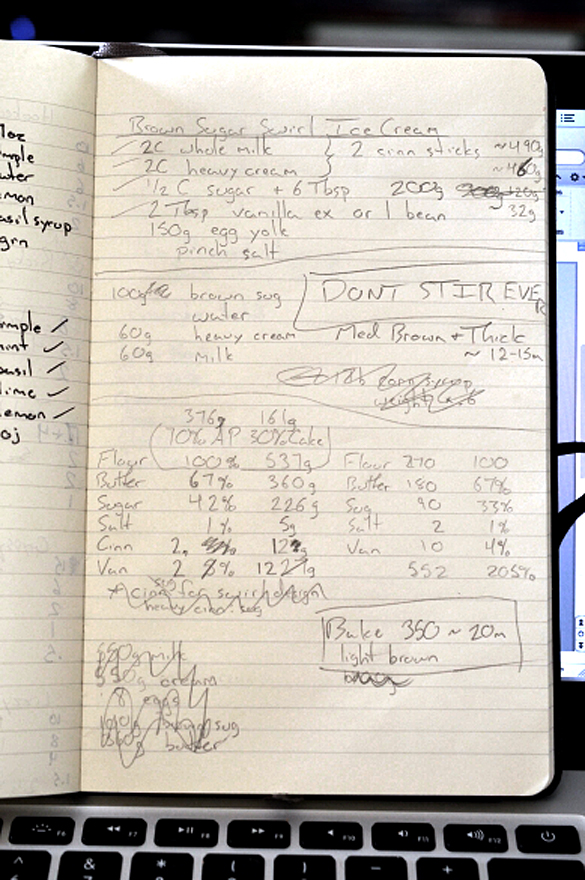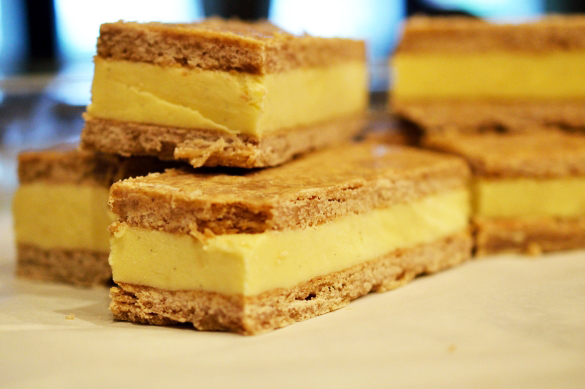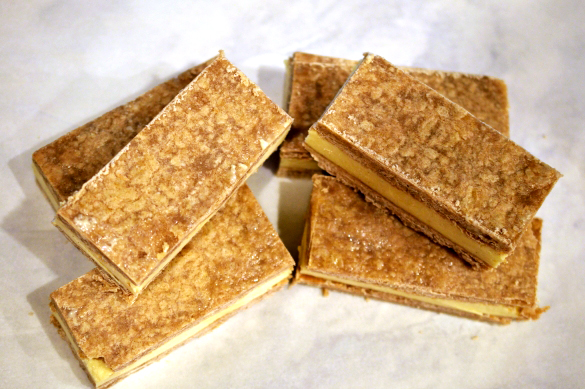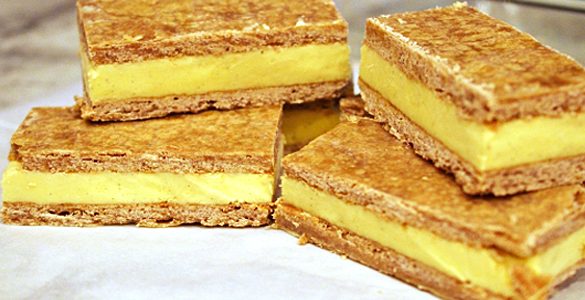
Play with Your Food: Brown Sugar Caramel-Cinnamon Ice Cream Sandwiches
By Nick Wuest, former ICC Pastry Arts student
In my ever-growing collection of notebooks there is a small one that contains random, vague ideas that I constantly tell myself I’ll expand upon one day. In that book there is a line that reads “ct-crunch bars.” The dream came about through the process of rejuvenating the WWE Superstar Bar and an undying love for all things Cinnamon Toast Crunch.
What turned that little scribble into a reality is a little thing called “baker’s math.” Last week we covered it in class and it wasn’t just a light bulb moment, it was a lightning bolt to the brain. Thanks to the pastry arts program there’s no “credit where it’s due” section this time around. This whole recipe came from an understanding of ingredient function and the use of baker’s percentage to develop exactly what I needed to turn “ct-crunch bars” into this:

BROWN SUGAR CARAMEL ICE CREAM
This particular formula comes in two stages. Stage one is the custard, which will become the ice cream. Stage two is the brown sugar caramel, which will be cooked and cooled around the time the ice cream is processed, then mixed in.
- 490g whole milk
- 460g heavy cream
- 2 cinnamon sticks, split
- 1 vanilla bean, split and scraped
- 200g sugar, divided 150g and 50g
- 150g egg yolks
- pinch of salt
Bring milk, cream, cinnamon, and vanilla to boil. Remove from heat, cover and steep 15 min.
Remove cinnamon and vanilla bean, return to heat, add 150g sugar, bring to just below boil. Whisk yolks and 50g sugar in bowl to thicken. Temper eggs with hot cream, return to heat. Cook mixture, stirring constantly, until thick enough to coat a wooden spoon. Strain well into an ice bath, stir in salt. Cool custard then chill until ready to freeze up to 2 days.

CINNAMON SHORTBREAD COOKIES
This recipe, along with many future ones will be written a little differently than you may be used to. To understand it you’ll need to know how baker’s percentage works. The short of it is this: baker’s percentage is the ratio of ingredients to the total weight of flour in a recipe (the flour being 100%).
Knowing how ingredients function in a recipe allows you to bend the percentages to your needs. For example I know that since this cookie is meant to be frozen it has to be very soft and chewy. I also know that sugar inhibits gluten development and tenderizes. So I used some low protein flour and extra sugar to create a cookie that when baked has a texture closer to cookie dough that melts in your mouth and doesn’t crisp up in the freezer.
- 376g AP flour
- 161g cake flour (add these two weights together for 100%)
- 360g butter, room-temp cubes (67%)
- 226g sugar (42%)
- 5g salt (1%)
- 12g ground cinnamon (2%)
- 12g vanilla paste (2%)
Sift the flours, salt, and cinnamon together, set aside.
Cream butter and sugar very light and fluffy, mix in vanilla paste to just combine.
Add flour mixture in 3 batches, just combining each addition, until the dough comes together. Do the last stage of mixing (mostly combined with some dry sand in the bottom of the bowl) by hand. Shape the dough into a rectangle, wrap well and chill about 30 min.
Heat oven to 350F. Roll dough between two pieces of parchment to about ½” thick rectangle, transfer to sheet pan, remove top sheet, brush lightly with egg wash. Bake about 20 minutes until edges are lightly brown. The cookie sheet will be very tender as it cools so handle it gently. Cool in pan on rack completely.
Handle the cookie sheet very gently from here on. Once the sheet has cooled, trim the edges and cut the sheet into equal halves that will fit in a casserole. And don’t you dare throw away those scraps!

BROWN SUGAR CARAMEL SAUCE & ASSEMBLY
The cookie sheets are cut and the custard is ready to process. It’s time to assemble the bulk sheet and freeze it.
- 100g light brown sugar
- 60g heavy cream
- 60g milk
Combine the sugar and enough water until it resembles wet sand in a small saucepan, bring to a boil and cook about 2 minutes. Remove the pan from the heat, add the cream and milk, swirl in the pan to mix.
(You’ll want to stir it, and if you notice the note on that page above that says ‘DON’T STIR EVER.’ I knew this and like an impatient child stirred it. Stirring facilitates crystallization resulting is a grainy sauce that dries to a matte finish. In this case it doesn’t matter but in the future just don’t do it.)
Cook the sauce until it is very thick, cool in an ice bath.
As the caramel cools process the ice cream in an ice cream maker. Line the casserole with parchment, leaving overhangs (to remove the frozen block) and place one cookie sheet inside.
Once the ice cream hits soft serve slowly add the caramel sauce to just swirl it in (if it incorporates it’s no big deal). Pour the ice cream into the casserole over the cookie sheet, smooth it out, and place the other sheet on top. Cover and freeze overnight.
Remove the block, trim the edges, cut out desired shapes, serve or hoard them all for yourself (both are acceptable).

This project was a lot of fun. I got into pastry arts for the scientific approach bakers take to creating new recipes (some bakers even prefer the term formula). I’ve developed recipes before but until learning about baker’s math this week the process was more akin to throwing darts at numbers on a board until things worked. To see a better system work so well right away is very encouraging as I grow as a cook.
As for the ice cream sandwiches I hope you enjoy them. I know I enjoyed creating them. They aren’t too tough to make and provide great practice with mise en place and a good workflow as you transition from step to step. Oh yeah, and they are awesome! The cookies are super tender and bring out the little bit of spice in the ice cream, which is very sweet and refreshing. Both the cookie and ice cream melt in your mouth as they warm making for a very pleasant experience.
I hope you enjoyed your holiday weekend (the two USDA Prime NY strips grilling as I finish up here lock in an A+ for my holiday) as well as the post. As always, thanks for reading and stay hungry.
This blog post was originally published by the International Culinary Center (ICC), founded as The French Culinary Institute (FCI). In 2020, ICE and ICC came together on one strong and dynamic national platform at ICE's campuses in New York City and Los Angeles. Explore your culinary education where the legacy lives on.


Add new comment